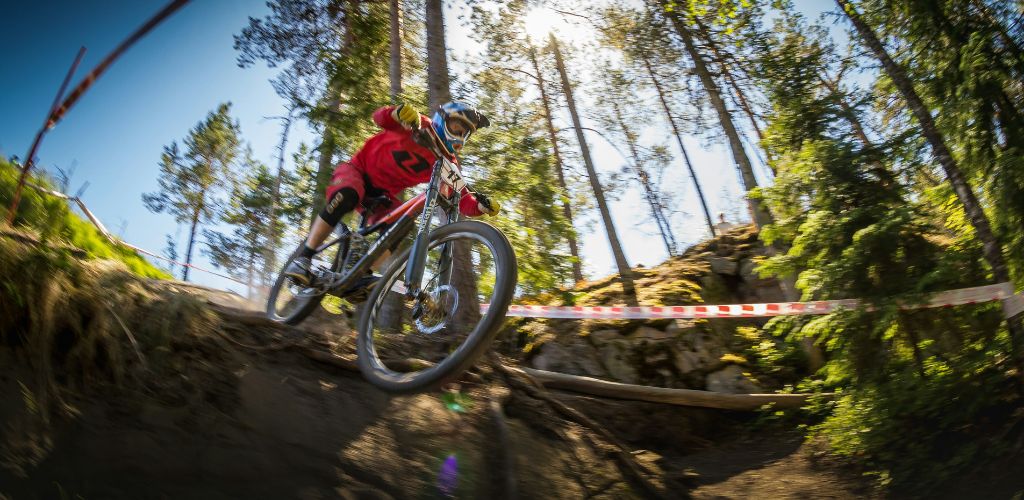Downhill mountain biking, often seen as a gravity-fueled adventure, is indeed a robust form of exercise.
Cardiovascular Benefits
Contrary to common perception, downhill mountain biking can offer significant cardiovascular benefits.
While it’s true that the gravity-assisted nature of the sport means less continuous pedaling compared to other biking disciplines, the physical demands of controlling the bike in challenging terrain still contribute to cardiovascular health.
Rapid heart rate increases during intense parts of the descent are akin to interval training, though less sustained than traditional forms. This can still benefit heart health, albeit in a different way than steady-state cardio exercises.
What makes downhill biking stand out is the varied intensity.
During a descent, your heart rate spikes, and then, as you pedal or hike back up, you maintain a moderate level of cardiovascular activity. This variation is beneficial for heart health as it trains your heart to adapt to different levels of demand.
Additionally, the adrenaline rush experienced during a downhill ride can also contribute to cardiovascular health. The thrill of the ride, the focus on the trail, and the excitement all contribute to an elevated heart rate, adding to the workout’s intensity.

Building Muscular Strength and Endurance
Downhill mountain biking is intense on the muscles.
The primary engagement comes from the core, arms, and legs, but in a different capacity than endurance cycling. The effort lies in controlling the bike over difficult terrain, which requires bursts of muscular power and a constant engagement of the core for balance.
When you ride downhill, many muscles throughout your body are in a constant state of tension while trying to relax and remain fluid wherever possible, reacting to the terrain.
The rapid contractions and releases of muscles during a downhill ride are excellent for building muscular endurance and explosive strength, particularly in the lower body.
The constant need to stabilize the bike and absorb shocks from the terrain means that your leg muscles are always engaged. This engagement leads to increased muscle tone and strength over time.
Downhill biking is a form of isometric exercise for the legs, where the muscles are contracted against a force without much movement, like holding a squat position while going over bumps.
Your upper body and core also play crucial roles. Steering and controlling the bike require a strong upper body, especially the arms, shoulders, and back. The constant adjustments and corrections made during a ride engage these muscles in a way that is akin to dynamic weightlifting.
Your core muscles – the abs, obliques, and lower back – are the foundation for your biking posture and are continuously engaged to maintain balance and stability. This constant engagement helps in building a strong, stable core, essential not just for biking, but for overall physical health.

Mental Health and Stress Reduction
The mental health benefits of downhill mountain biking are substantial and deserve a mention here – I know this from first hand experience.
The need for concentration and focus during a downhill ride provides a mental workout that can be as intensive as the physical one. This level of concentration can lead to a state of flow, where the mind is fully immersed in the activity, providing a mental break from daily stressors and worries.
The psychological benefits of physical exertion, combined with the thrill and excitement of downhill biking, contribute to a significant release of endorphins, the body’s natural stress-relievers and mood enhancers.
This endorphin release can lead to feelings of euphoria, a kind of “mountain biker’s high,” similar to the well-known “runner’s high.” It is a wonderful feeling – I’ve described it to non-riding buddies as a kind of exhausted satisfaction, elated and stoked that you’re survived all the challenges (mental and physical), and feeling thrashed yet extremely happy. This is usually the time me and my riding friends will grab a cold beverage and some good food, to refuel and relive our close calls in story form!
Moreover, the outdoor setting where downhill biking typically takes place can significantly impact mental health.
Natural environments are known to have a calming effect on the mind, reducing symptoms of stress and anxiety. The fresh air, natural light, and scenic views that come with biking in the mountains or forests contribute to a sense of well-being and tranquility.

Weight Management and Caloric Burn
Finally, let’s examine in detail how downhill mountain biking contributes to weight management and caloric burn.
While it’s true that the high-intensity bursts of a downhill ride might not last as long as other continuous forms of exercise, the overall calorie burn can be significant.
The intense physical effort required to maneuver and control the bike on steep, challenging terrain burns a considerable number of calories.
The ascent, whether by pedaling or hiking with the bike, should not be underestimated. This part of the sport can be as demanding as the descent, contributing significantly to your daily calorie expenditure.
The effort to climb hills, especially with the added weight of a downhill bike, is substantial and can burn a significant number of calories, aiding in weight management.
Obviously sometimes we’re shuttling with our bikes, or riding at a bike park with a chairlift, but most riders involved in downhill will spend at least some portion of their riding days hiking back up the hill!
Moreover, downhill mountain biking is often a full-day activity.
The cumulative effect of several runs, along with the physical effort required to get to the top of the trail each time, results in a considerable amount of total calorie burn.
This makes downhill biking an effective complement to a balanced exercise regimen for those looking to manage or lose weight.

The bottom line…
Downhill mountain biking is not only an exhilarating sport but also a comprehensive form of exercise – despite being gravity assisted!
It offers numerous benefits, including improved cardiovascular health, increased muscular strength and endurance, enhanced mental health, and effective weight management.
It’s a sport that engages your entire body and mind, providing a unique and enjoyable way to stay fit and healthy.
As with any high-intensity sport, it’s important to approach downhill mountain biking with caution, gradually building up your skills and fitness level, as it’s certainly one of the most dangerous forms of mountain biking.
Still, in my eyes, it’s well worth while to get involved. Personally, I’m not the fastest downhill rider around, or hitting some of the massive jumps out there, but I still have a heap of fun, and thankfully haven’t injured myself too badly in the process, touch wood.
See you on the trail!

